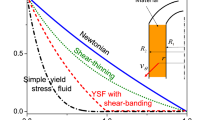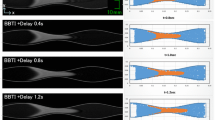Abstract
Abstract
Here, we report on the feasibility and use of magnetic resonance imaging-based methods to the study of electrohydrodynamic (EHD) liquid bridges. High-speed tomographic recordings through the longitudinal axis of water bridges were used to characterize the mass transfer dynamics, mixing, and flow structure. By filling one beaker with heavy water and the other with light water, it was possible to track the spread of the proton signal throughout the total liquid volume. The mixing kinetics are different depending on where the light nuclei are located and proceeds faster when the anolyte is light water. Distinct flow and mixing regions are identified in the fluid volumes, and it is shown that the EHD flow at the electrodes can be counteracted by the density difference between water isotopes. MR phase contrast imaging reveals that within the bridge section, two separate counter-propagating flows pass one above the other in the bridge.
Graphical Abstract










Similar content being viewed by others
References
Benson MJ, Elkins CJ, Mobley PD, Alley MT, Eaton JK (2009) Three-dimensional concentration field measurements in a mixing layer using magnetic resonance imaging. Exp Fluids 49:43–55. doi:10.1007/s00348-009-0763-x
Bernstein MA, King KF, Zhou XJ (2004) Handbook of MRI pulse sequences. Elsevier, Amsterdam
Burcham CL, Saville DA (2002) Electrohydrodynamic stability: Taylor–Melcher theory for a liquid bridge suspended in a dielectric gas. J Fluid Mech 452:163–187. doi:10.1017/S0022112001006784
Engel A, Friedrichs R (2002) On the electromagnetic force on a polarizable body. Am J Phys 70:428. doi:10.1119/1.1432971
Fuchs EC, Woisetschläger J, Gatterer K, Maier E, Pecnik R, Holler G, Eisenkölbl H (2007) The floating water bridge. J Phys D Appl Phys 40:6112–6114. doi:10.1088/0022-3727/40/19/052
Fuchs EC, Gatterer K, Holler G, Woisetschläger J (2008) Dynamics of the floating water bridge. J Phys D Appl Phys 41:185502. doi:10.1088/0022-3727/41/18/185502
Fuchs EC, Bitschnau B, Di Fonzo S, Gessini A, Woisetschläger Bencivenga F (2011) Inelastic UV scattering in a floating water bridge. J Phys Sci Appl 1:135–147
Graessner J (2013) Bandwidth in MRI? MAGNETOM Flash, 2:3–8. http://www.siemens.com/magnetom-world
Grundmann S, Wassermann F, Lorenz R, Jung B, Tropea C (2012) Experimental investigation of helical structures in swirling flows. Int J Heat Fluid Flow 37:51–63. doi:10.1016/j.ijheatfluidflow.2012.05.003
Haacke EM, Brown RW, Thompson MR, Venkatesan R (1999) Magnetic resonance imaging—physical principles and sequence design. Wiley, New York
Marín AG, Lohse D (2010) Building water bridges in air: electrohydrodynamics of the floating water bridge. Phys Fluids 22:122104. doi:10.1063/1.3518463
Melcher JR, Taylor GI (1969) Electrohydrodynamics: a review of the role of interfacial shear stresses. Annu Rev Fluid Mech 1:111–146. doi:10.1146/annurev.fl.01.010169.000551
Morawetz K (2012) Theory of water and charged liquid bridges. Phys Rev E Stat Nonlinear Soft Matter Phys 86:1–9. doi:10.1103/PhysRevE.86.026302
Narten A (1964) Thermodynamic effects of mixing light and heavy water. J Chem Phys 41:1318. doi:10.1063/1.1726066
Quesson B, de Zwart JA, Moonen CT (2000) Magnetic resonance temperature imaging for guidance of thermotherapy. J Magn Reson Imaging 12:525–533
Reike V, Pauly KB (2008) MR Thermometry. J Magn Res Imag 27:376–390. doi:10.1002/jmri.21265
Reiter U, Reiter G, Kovacs G, Stadler AF, Gulsun MA, Greiser A, Olschewski H, Fuchsjäger M (2013) Evaluation of elevated mean pulmonary arterial pressure based on magnetic resonance 4D velocity mapping: comparison of visualization techniques. PLoS One 8:e82212. doi:10.1371/journal.pone.0082212
Sammer M, Wexler A, Kuntke P, Wiltsche H, Stanulewicz N, Lankmayr E, Woisetschläger J, Fuchs EC (2015) Proton production, neutralisation and reduction in a floating water bridge. J Phys D Appl Phys 48:415501. doi:10.1088/0022-3727/48/41/415501
Smith JN, Flagan RC, Beauchamp JL (2002) Droplet evaporation and discharge dynamics in electrospray ionization. J Phys Chem A 106:9957–9967. doi:10.1021/jp025723e
Van De Meent JW, Sederman AJ, Gladden LF, Goldstein RE (2010) Measurement of cytoplasmic streaming in single plant cells by magnetic resonance velocimetry. J Fluid Mech 642:5. doi:10.1017/S0022112009992187
Wang F-N, Peng S-L, Lu C-T, Peng H-H, Yeh T-C (2013) Water signal attenuation by D2O infusion as a novel contrast mechanism for 1H perfusion MRI. NMR Biomed 26:692–698. doi:10.1002/nbm.2914
Wassermann F, Loosmann F, Egger H, Grundmann S, Tropea C (2014) Flow through tetradecahedrons. Paper presented at the 17th international symposium on applications of laser techniques to fluid mechanics Lisbon, Portugal, 07–10 July, 2014
Weishaupt D, Köchli VD, Marincek B (2008) How does MRI work?: an introduction to the physics and function of magnetic resonance imaging. Springer, Berlin
Wexler AD, López Sáenz M, Schreer O, Woisetschläger J, Fuchs EC (2014) The preparation of electrohydrodynamic bridges from polar dielectric liquids. J Vis Exp. doi:10.3791/51819
Wexler AD, Drusová S, Woisetschläger J, Fuchs EC (2016) Non-equilibrium thermodynamics and collective vibrational modes of liquid water in an inhomogeneous electric field. Phys Chem Chem Phys 18:16281. doi:10.1039/c5cp07218b
Widom A, Swain J, Silverberg J, Sivasubramanian S, Srivastava YN (2009) Theory of the Maxwell pressure tensor and the tension in a water bridge. Phys Rev E 80:016301. doi:10.1103/PhysRevE.80.016301
Woisetschläger J, Gatterer K, Fuchs EC (2010) Experiments in a floating water bridge. Exp Fluids 48:121–131. doi:10.1007/s00348-009-0718-2
Woisetschläger J, Wexler AD, Holler G, Eisenhut M, Gatterer K, Fuchs EC (2012) Horizontal bridges in polar dielectric liquids. Exp Fluids 52:193–205
Acknowledgments
This work was performed in the cooperation framework of Wetsus, European Center of Excellence for Sustainable Water Technology (http://www.wetsus.eu). Wetsus is co-funded by the Dutch Ministry of Economic Affairs and Ministry of Infrastructure and Environment, the Province of Fryslân, and the Northern Netherlands Provinces. ADW, SD, ECF, and JW wish to thank the participants of the research theme Applied Water Physics for the fruitful discussions and their financial support.
Author information
Authors and Affiliations
Corresponding author
Electronic supplementary material
Below is the link to the electronic supplementary material.
Rights and permissions
About this article
Cite this article
Wexler, A.D., Drusová, S., Fuchs, E.C. et al. Magnetic resonance imaging of flow and mass transfer in electrohydrodynamic liquid bridges. J Vis 20, 97–110 (2017). https://doi.org/10.1007/s12650-016-0379-1
Received:
Revised:
Accepted:
Published:
Issue Date:
DOI: https://doi.org/10.1007/s12650-016-0379-1




